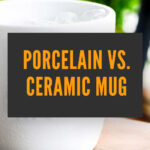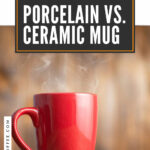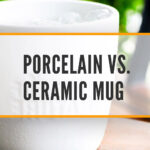For the typical coffee drinker, there are two main types of coffee mugs: porcelain and ceramic. For more serious coffee fans, glass mugs are also a great option (arguably the best), and when manufactured correctly, porcelain should feel like glass. However, in this article, we’re just looking at clay-based mugs.
Porcelain and ceramic have their own unique benefits and drawbacks, so it’s important to know the difference before making a purchase. But many people don’t know that there is a difference.
So, in this blog post, we will discuss exactly this. What are the differences between porcelain vs. ceramic mugs? We’ll also answer some common questions about porcelain and ceramic mugs. So, let’s get started!
Need some other coffee accessories? Check out our guide!
What is Porcelain?

Before diving into the nitty-gritty and pitting one mug material against the other, we should look at what exactly these two materials are.
Well, porcelain is technically just a more expensive type of ceramic. It’s usually made from white kaolin clay. It is fired at a high temperature, which makes it harder and more durable than other types of ceramic. Nonetheless, porcelain mugs have thinner walls and are lighter than ceramic mugs.
What is Ceramic?

In contrast, ceramic is a type of clay made from a mix of different minerals. It is fired at a lower temperature than porcelain, which makes it less durable and more prone to cracking.
Ceramic coffee mugs often have a thicker wall and are heavier than their porcelain counterparts.
What Porcelain and Ceramic Have in Common
So, what do porcelain and ceramic mugs have in common? For starters, they are both made from clay. They are also fired at high temperatures, giving them a similar appearance. But the exact temperature they are fired at is different.
Another similarity is the glaze used to finish these mugs. They are both usually finished with a glossy glaze that can be either clear or colored, giving them a smooth texture. Technically, this glaze touches your coffee drinks, not the porcelain or ceramic itself.
Porcelain vs Ceramic Mugs: What are the Differences?
Now that we know what each type of mug is made of, let’s discuss the key differences between them.
Porcelain mugs are fired at a higher temperature than ceramic mugs. True porcelain is fired at 2,650 degrees Fahrenheit, to be precise – an incredibly high temperature! This makes the material harder and more durable.
In contrast, ceramic mugs are fired at a lower temperature – typically between 1,800 Fahrenheit and 2,400 Fahrenheit – which makes them less durable.
In terms of the construction of these mugs, although porcelain is technically the harder material, porcelain mugs tend to be thinner and daintier than ceramic mugs. On the other hand, ceramic mugs are often thicker and heavier – these are the average cups coffee lovers most likely have in their cupboards right now.
Lastly, another difference between porcelain and ceramic mugs is the price. Porcelain mugs are typically more expensive than ceramic mugs because of the process used to create them and their typically more elaborate design.
Pros and Cons of Ceramic Mugs
So, let’s explore some of the pros of ceramic, and some of the cons, of course.
Pros
First of all, ceramic mugs are very common and easy to find. You can find them at most stores, and they come in a wide variety of colors, shapes, and sizes.
They are usually less expensive than porcelain mugs, making them a great option if you’re on a budget. They are typically microwave and dishwasher-safe, which is great if you tend to let your drinks go cold.
Cons
Ceramic mugs can be quite heavy, so they might not be the best option if you’re looking for a cup that is easy to carry around.
Ceramic mugs are also less sturdy than porcelain cups, so they are less likely to crack, chip, or break if you accidentally drop them.
Lastly, they are typically not as well designed – hence why they are cheaper!
Pros and Cons of Porcelain Mugs
Next up are the pros and cons of porcelain!
Pros
Compared to ceramic, porcelain mugs are typically thinner and lighter.
Their design is typically fancier than ceramic mugs as well. In fact, this is the main difference between the two and what sets porcelain mugs apart – they are designed to be more delicate and elegant.
They are made from a durable material less prone to chipping or cracking.
Cons
Nonetheless, the main downside of porcelain mugs is that they can feel much more delicate because of their thin and light quality.
They can also be quite expensive, usually because of their more elaborate design and more complicated creation process.
Lastly, they might not be microwave or dishwasher-safe – either because of their high-temperature firing process, because of their delicate design, or particularly if they are hand-painted.
Does the Mug’s Material Affect the Taste of the Coffee?
For the flavor of coffee, ceramic is the best choice. Because ceramic is a solid and non-reactive substance, it absorbs and gives off no taste, allowing the coffee to taste exactly how it should.
Porcelain is also a great option for coffee mugs because it is non-reactive. This means that, like ceramic, it also shouldn’t affect the taste of your drink.
Which holds heat better?
Typically, both ceramic and porcelain mugs will do an excellent job of keeping your coffee hot. However, porcelain tends to be a bit better in this department because it is less porous than ceramic. This means that there are fewer nooks and crannies for heat to escape.
How can you tell the difference between porcelain and ceramic?
So, how do you tell the difference between these two types of coffee mugs? Well, of course, you can look underneath and see what material it’s made of, but if you want to tell the difference at a glance, here are a few things to look out for.
Fancy porcelain mugs are usually thinner and more delicate-looking than ceramic mugs. So, if you see a tiny mug decorated with an intricate floral design, it’s much more likely to be made from porcelain than ceramic.
In contrast, if you see a thicker and more sturdy-looking mug with a simple design or plain color, it’s much more likely to be ceramic.
Think of your typical two-dollar mug from the supermarket versus a delicate set from an expensive crockery store.
Are they microwave-safe?
Another great thing about these mugs is that, for the most part, they are both microwave-safe. This means that you can heat your coffee in the mug without having to transfer it to another container.
However, there are a few things to keep in mind. First, make sure that the mug is made from 100% ceramic or porcelain – no metal accents or other materials.
Secondly, always check for the microwave-safe symbol before putting it in the microwave. And lastly, if these mugs have any hand-painted designs (this is usually porcelain as opposed to ceramic), they are typically not suitable for a microwave.
But no matter – this just means you have to drink your cup of coffee before it gets cold!
Conclusion
So, what’s the verdict? Are porcelain mugs better than ceramic?
Well, truth be told, it depends on your preference. But ceramic is probably the way to go for a standard everyday coffee mug. It’s fairly durable, less expensive, and microwave-safe. And it’s cheaper to build up an impressive coffee mug collection with ceramics.
Porcelain mugs are a great choice for coffee drinkers looking for something a bit more delicate and elegant, perhaps for a nice dinner party or family get-together. And they’re certainly more likely to impress your guests.
But whichever mug you choose, the contents will undoubtedly be delicious, and even the fanciest of dinner guests will surely use a ceramic mug from time to time!
Happy Caffeinating!



















